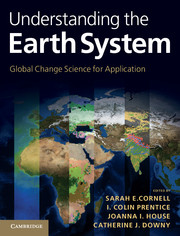Book contents
- Frontmatter
- Contents
- Editors
- Scientific editorial team members
- Contributing authors
- Foreword
- Preface
- Acknowledgements
- Units
- 1 Earth system science and society
- 2 Fundamentals of climate change science
- 3 How has climate responded to natural perturbations?
- 4 The Earth system feedbacks that matter for contemporary climate
- 5 Earth system models
- 6 Climate change impacts and adaptation
- 7 The role of the land biosphere in climate change mitigation
- 8 Society’s responses and knowledge gaps
- Acronyms
- Glossary of terms
- Index
- References
5 - Earth system models
A tool to understand changes in the Earth system
Published online by Cambridge University Press: 05 November 2012
- Frontmatter
- Contents
- Editors
- Scientific editorial team members
- Contributing authors
- Foreword
- Preface
- Acknowledgements
- Units
- 1 Earth system science and society
- 2 Fundamentals of climate change science
- 3 How has climate responded to natural perturbations?
- 4 The Earth system feedbacks that matter for contemporary climate
- 5 Earth system models
- 6 Climate change impacts and adaptation
- 7 The role of the land biosphere in climate change mitigation
- 8 Society’s responses and knowledge gaps
- Acronyms
- Glossary of terms
- Index
- References
Summary
This chapter provides an overview of Earth system models, the various model ‘flavours’, their state of development including model evaluation, benchmarking and optimization against observational data and their application to climate change issues.
Introduction
The Earth system can be conceptualized as a suite of interacting physical, chemical, biological and anthropogenic processes that regulate the planet’s low of matter and energy. Earth system models (ESMs; Box 5.1 ) are built to mirror these processes. In fact, ESMs are the only tool available to the scientific community to investigate the system properties of the Earth, as we do not have an alternative planet to manipulate that could serve as a scientist’s laboratory.
The term ‘Earth system model’ is commonly used to describe coupled land–ocean–atmosphere models that include interactive biogeochemical components. Such models have developed progressively from the physical climate models first created in the 1960s and 1970s. Conventional climate models apply physical laws to simulate the general circulation of atmosphere and ocean. As our understanding of the natural and anthropogenic controls on climate has grown, and given the steady advances in computing power, global climate models have been extended to include more comprehensive representations of biological and geochemical processes, involving the addition of the various interacting components of the Earth system with their own feedback mechanisms. Figure 5.1 shows the conceptual differences between a conventional global coupled atmosphere–ocean general circulation model (AOGCM) and an ESM. In terms of the coupling between components, ESMs are more complex, and they have correspondingly higher computational demands.
- Type
- Chapter
- Information
- Understanding the Earth SystemGlobal Change Science for Application, pp. 129 - 159Publisher: Cambridge University PressPrint publication year: 2012
References
- 3
- Cited by



